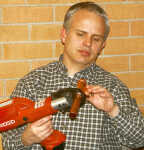School board studies half-million dollar air conditioning plans

McCook's junior high school will be air conditioned this summer if the board of education proceeds with one of the two proposals made during a special board meeting Tuesday evening.
Installing air conditioning in the 43-year-old building could cost as much as half a million dollars.
The board wants to air condition the junior high before it air conditions the senior high, the only other building in the school district that is not air conditioned. Jim Jumps, who works in the school district's maintenance division and is in charge of its buildings' heating and cooling systems, said the junior high's design makes for hotter classrooms and more-uncomfortable teachers and students.
Rick Haney, the school district's finance director, said the junior high is typically six to 10 degrees warmer than the senior high.
The heat from the junior high cafeteria kitchen rises into classrooms above it, Jumps said, and second-level classrooms that open into the center hall have no windows that can be opened for fresh air and air circulation. "The heat is ungodly in those classrooms," Jumps said.
Haney said, too, that administration and board members are considering the difference in maturity level between junior and senior high students. "High school kids can handle the heat better than junior high kids," Haney said. McCook's junior high has 300 sixth, seventh and eighth graders, plus staff and teachers.
The junior high was completed in the fall of 1966, and its design included air conditioning that, for whatever reason, was not installed. One thought in cooling the building now involves using and enhancing the building's existing heating system to add air conditioning; another is to expand the system to create a more flexible heating and cooling system.
A new cooling system would be paid for over two budget cycles, Haney said. Funds squirreled away for the past two years in a long-range planning fund will come close to covering the cost of the junior high project, he said.
Haney said that federal government stimulus and recovery funds -- which school officials thought could be used to buy air conditioning -- may have strings attached to them that require they be used for Title and early childhood/special education, rather than bricks-and-mortar projects. However, Haney said, Gov. Dave Heineman may decide to put $230 million in federal stimulus funds into Nebraska's state aid to schools program, at which point McCook may be able to use its portion for bricks-and-mortar projects.
Two companies made presentations to air condition the junior high Tuesday evening, explaining system options and offering cost estimates, not bids. Depending upon the option chosen, the air conditioning system could cost anywhere from $250,000 to just more than $500,000.
After the presentations, Greg Wolford and April Hock, of W Design, McCook, said they will ask many more questions and seek clarification on proposals from each company. Wolford said they will come to the April 14 board meeting, with answers, more information and a written recommendation to the board.
TRANE
The Trane team of Dave Raymond and Don Tabor of Omaha and Larry Cihal of Kearney explained the "2-pipe" and "4-pipe" systems, either of which would work in the junior high.
The 2-pipe option would use the hot water pumps, coils, piping and air handlers already in the building to circulate cold water. Using this system, the entire building would either be heated or cooled.
The 4-pipe option would add a second coil system and additional piping and pumps to create a system in which the boilers and chillers would operate independently, and the building could be heated and cooled at the same time. Individual air handlers (in eight zones) could provide heating in the north classrooms, Jumps said, while cooling classrooms on the south side or down the south hallway at the same time.
Trane's "energy/comfort optimization" option, a third more expensive option that could be considered as a future enhancement, would fine-tune the heating/cooling system to allow heating or cooling of individual rooms and would include a variable air volume control system.
SIEMENS
In 1998, the school board utilized a lease/purchase agreement to hire Siemens to install new windows and enhance heating/air circulation in the junior and senior high buildings.
Ron Paul of Siemens' Kearney office told board members that he recommends a 4-pipe system in the junior high. If needed, he said, the school would be able to heat in the morning and cool in the afternoon.
A 4-pipe system is more efficient, he said, and explained that he is concerned that the existing piping could be undersized and not designed to carry chilled water. He said, too, that the 43-year-old piping could expand, contract and crack with the changes in water temperature from 180 degrees to 40 degrees.
Paul told board members, "Jim (Jumps) maintains your system better than most, but it is still 43 years old."
